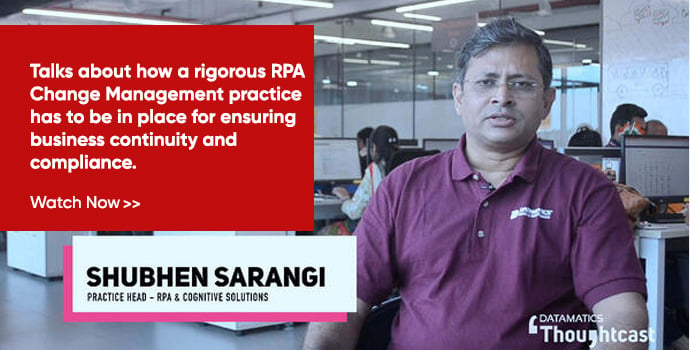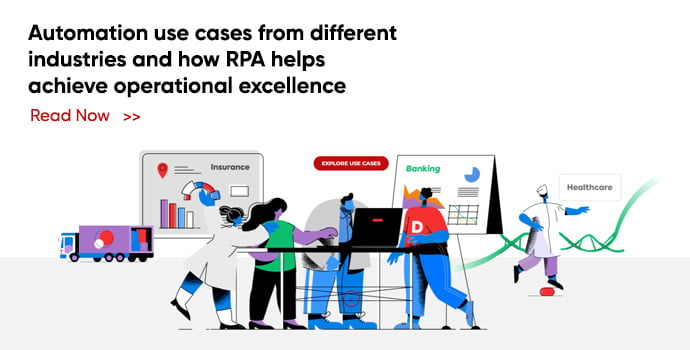3 pillars of RPA Change Management for a successful implementation
by Sachin Rane, on Feb 21, 2020 9:17:34 PM
Estimated reading time: 3 mins
Robotic Process Automation (RPA) solution implementation has to be a multi-functional approach. Achieving the right business results within the stipulated time should be the goal and the measurement of success for an organization-wide RPA solution implementation. This goal is achieved only through a self-imposed RPA Change Management discipline, which is institutionalized through comprehensive program governance and is instilled through an RPA Centre of Excellence (CoE).

I think an RPA CoE is quintessential in the RPA implementation exercise and forms the foundation for building the pillars of RPA Change Management discipline. While RPA, which is essentially a part of Business Process Management (BPM) software stack, rides on the back of its ally Artificial Intelligence (AI) / Machine Learning (ML), this technology duo is becoming increasingly invisible and invincible at the same time, as they get shrouded under the hood of automation. The “would you also like” menu on a digital marketplace site, the “fastest routes options while booking a travel ticket”, etc., are all a part of this invisible invincibility. However, the fact remains that for implementing structure in a highly unstructured world of data or so to say “bring the method to the madness”, you need an RPA CoE with an RPA Change Management discipline at the helm for reaping the most RoI.
What are the 3 pillars of RPA Change Management?
RPA Change Management depends on:
- Stakeholder management
- Expectation management
- Process re-design
Here are the three pillars that hold together the RPA Change Management discipline on the foundation of an RPA CoE:
1. Stakeholder management:The entire enterprise, including Business, IT, and HR, should participate in the RPA deployment journey through the creation of appropriate instruments such as training, processes, and policies. But first of all, you should get the buy-in of the C-suite. This stakeholder management is the first step towards RPA Change Management.
RPA Change Management is “a process by the people, for the people”, with re-orientation required right from the shop floor to the C-suite. An RPA CoE set up at the onset goes a long way in not only identifying but also engaging all the stakeholders throughout the RPA journey. The RPA CoE is also instrumental in developing a Responsible-Accountable-Consulted-Informed (RACI) role matrix for implementing a strong RPA governance and compliance view.
Focus on the fact that RPA does not require additional IT infra resources. However, IT involvement is mandatory to deploy and maintain the technology on enterprise servers. Keep in mind that you should avoid creating shadow IT at all costs so that security issues do not crop up and aggravate with time.
2. Expectation management:You should go beyond the stereotype that “RPA technology is faster, easier, and cheaper”. Be ready for push backs from different enterprise corners sensing the subversion of their key areas of influence.
Maintain the discretion that RPA RoI of 90 days is for medium-level complexity processes. The expected time for RoI tends to be on the higher side for increasing levels of process complexities.
The main part of socializing the RPA initiative is managing the enterprise expectations vis-a-vis the BPM software stack. The “as-is” and “to-be” state of operations has to be decided upfront before commencing the RPA exercise while considering the existing organizational talent pool, change in work processes, and the overall organizational change.
You need to conduct multiple rounds of enterprise sensitizations to set realistic expectations with respect to the cost, speed of process and RoI, as well as the resource reallocation to do more with the same number of resources.
3. Process re-design:Designate the RPA solution implementation as Lean Six Sigma process along with continuous process improvement to align with the optimum number of RPA capabilities. While going through the Define-Measure-Analyze-Improve-Control (DMAIC) journey you can effectively tailor the RPA solution to suit your business requirements.
Automation and process re-design go together. Keep in mind that if you are automating while still in a paper-based work environment, you also need very high-resolution scanners. Low-resolution records prove to be a bottleneck and hinder the very concept of automation.
You need to bake compliance and risk management into the process redesign. Educate all the stakeholders while stressing on the fact that RPA solutions enhance compliance through the creation of logs and audit trails at all touchpoints.
Implementation steps for successful RPA deployment |
Download infographic >
RPA use cases - A journey starts with the first step
In summary
RPA is the strongest ally in the BPM software stack. A successful RPA implementation, though desirable, is not elusive. Many global enterprises have reaped successes in their RPA journey. However, the fact remains that an RPA CoE that can institutionalize the RPA Change Management discipline is of prime importance. Here, stakeholder management, expectation management, and process re-design go a long way in the success of RPA implementation.




















